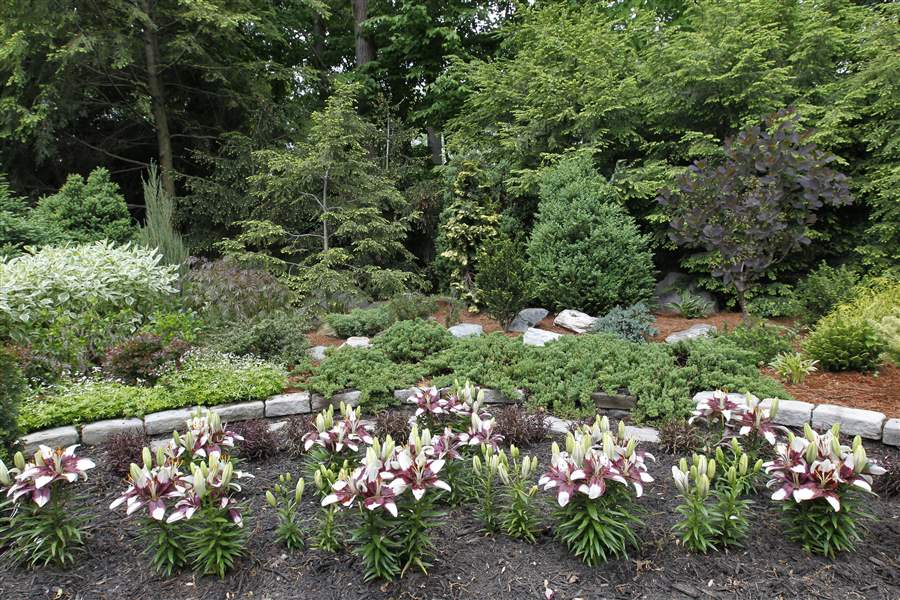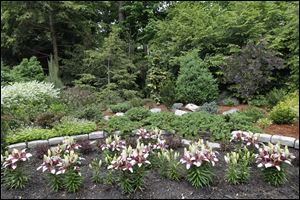
WEED IT & REAP
Gardening is a fun hobby for the Walinskis
5/28/2013
Richard and Shelley Walinski's Lilium Asiatic Tiny Padhye plants are among the few deciduous plants in their backyard garden in Ottawa Hills, Ohio.
The Blade/Lori King
Buy This Image

Richard and Shelley Walinski's Lilium Asiatic Tiny Padhye plants are among the few deciduous plants in their backyard garden in Ottawa Hills, Ohio.
Name: Richard and Shelley Walinski, attorney and volunteer, living in the Exmoor neighborhood of Ottawa Hills.
Garden specs: a 55-by-45-foot back yard. It's like having a little courtyard.
When did you start gardening? After we were married in 2005.
Shelley: I knew "green side up." My mother is a Master Gardener and she gave me tips.
Dick: I grew up in Old Orchard, cutting grass. Notice there's no grass. I've lived here since 1985 and had a patio but didn't use it. I golfed until my back pain became too great, then my obsession for golf turned into an obsession for the yard. Before we married, Shelley suggested I get some better patio furniture, so we did and we sat outside and noticed the yard was really awful.
PHOTO GALLERY: Click here to view more of the Walinski garden
What do you grow? The houses are close together, so we've worked very hard to achieve a visual barrier for privacy. At first we had all annuals; colorful and pretty but labor intensive and expensive. We mix normal-sized plants with dwarf specimens due to the limited size of the yard. We have species and subspecies of conifers (hemlocks, junipers, spruces, firs, pines, cypresses, arborvitae, and yews), of deciduous plants, and evergreens (crimson sentry, boxwoods, dogwoods, bamboos, carpenus, vibernum, chokeberry, cotoneaster), and japanese maple. Mixed in are ferns, astilbe, blue prince holly, hydrangeas, a redwood, and ornamental grasses including the cascading golden hakonechloa). This year Shelley replaced a bed of ground cover with a short Asiatic lily, maroon with white tips, called Tiny Padhye. The ground is mulched with a few inches of soft Georgia pine straw and set with large stepping stones.
Favorite plant: Shelley's is the fringe tree; it's been moved several times and is thriving in its current location. Dick's is New Gold Canadian Hemlock.
Give us a tip: Shelley: Visit as many public and private gardens as possible. We went on local garden tours and have gone to so many nurseries in Ohio and Michigan we thought about putting an "I Brake for Nurseries" sticker on the car. We used to think you had to have color, but we've worked to vary textures, shapes, and shades of greens. Dick: There's a beauty to bark and I'm thinning out some branches to show it. While I was on the board of Toledo Botanical Garden, I learned about verticality and invasive species.
Hours spent gardening per week: Eight. Shelley designs, handles the two-dozen pots, keeps things neat, researches plants, keeps the records, and has veto power. Dick designs, plants, transplants, and prunes.
Annual expense: Maintenance is about $1,500. Our expenses have decreased as we've acquired material that is compatible with our tastes and conditions of the garden. We have some rare tree specimens and have spent up to $3,000 for one. The price of dwarf trees is driven by how little they grow a year and we've spent up to $500 on one.
Challenges: Finding a variety of plants that are interesting and viable (given the clay soil in front and sandy soil in back), but not food stock for local wildlife. We're near Wildwood Metropark and are visited by deer, rabbits, and other common critters. Through trial and error, we've found which plants they don't eat. We no longer have some types of hostas but have kept varieties deer don't like, such as the large Sum and Substance. Deer resistant are cotoneaster, smoke bush, summersweet, sweet woodruff, boxwood, juniper, pine, fir, and spruce. We use deer-repellent products but it's more important to get plants that are deer-resistant.
We're proud of: Being able to configure an almost exclusively perennial garden with a variety of plants that thrive in the soil and restrictive lighting conditions that define our property.
What I've learned gardening: In July of our first gardening year when everything was most colorful and lush, we vowed we would never change a thing. We declared that it was perfect! We were to learn, as all gardeners do, that was a ridiculous idea. During the ensuing seven years, we have moved, replaced, or eliminated — at least twice — not only every plant in our yard, but every decorative feature as well.